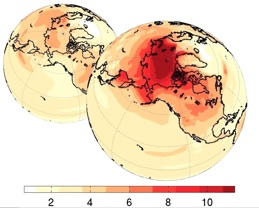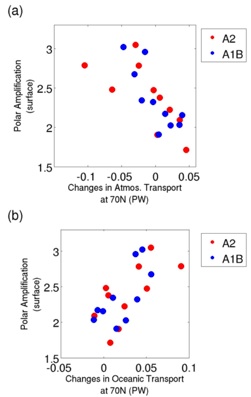Do changes in atmospheric poleward energy transports explain the large range in Arctic amplification seen in CMIP3 simulations? Definitely not. In fact, models with more polar amplification in 21st century projections show significantly less atmospheric energy transport into the Arctic (Figure 2a). Enhanced Arctic warming weakens the equator-to-pole temperature gradient and decreases atmospheric dry static energy transport, a decrease that often outweighs increases from atmospheric moisture transport. Increasing oceanic transport in most models is positively correlated with Arctic amplification (Figure 2b); however, the increase is too small to compensate the decrease of atmospheric energy transport and the causality of the positive correlation needs further investigation. Model spread in total energy transport cannot explain the model spread in polar amplification; models with great polar amplification must instead have stronger local feedbacks. Because local feedbacks affect temperature gradients, coupling between energy transports and Arctic feedbacks cannot be neglected when studying Arctic amplification.
Coupling between Arctic feedbacks and changes in poleward energy transport
Polar Amplification



Figure 1. Changes in surface temperature (K) from 2001~2020 to 2081~2100 in A2 scenario in GFDL CM2.0 model which has low Arctic amplification (left) and UKMO Hadgem1 model which has high Arctic amplification (right).
Full citation:
Hwang, Y.-T., Frierson, D. M. W., and J. E. Kay. Coupling between Arctic feedbacks and changes in poleward energy transport.** Geophys. Res. Lett., 38, L17704, doi: 10.1029/2011GL048546, 2011.
This work is one of AGU Editor’s highlights
Figure 2: Polar amplification in GCMs versus (a) changes in atmospheric energy transport at 70N (b) changes in oceanic energy transport at 70N. Blue dots are from the A1B scenario, and red dots are from the A2 scenario. Adapted from Hwang et al. 2011, Figure 2.